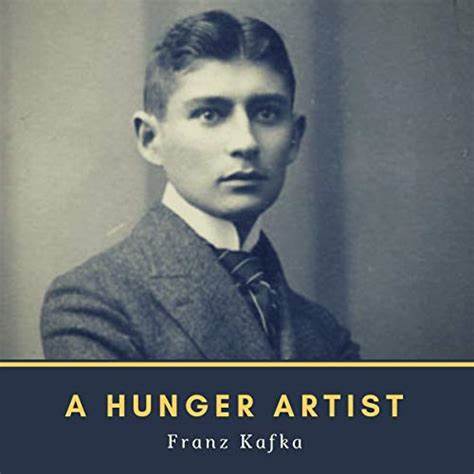A Hunger Artist (by Kafka)
Grades 5+
 The artist and his impresario, or manager, had been traveling through Europe for months. They had stopped in a small town in the countryside, at a public square near the town center. He is a fasting professional, who sees himself as an artist. In this case, he uses his body as a canvas to create a spectacle for the public. (5)
The artist and his impresario, or manager, had been traveling through Europe for months. They had stopped in a small town in the countryside, at a public square near the town center. He is a fasting professional, who sees himself as an artist. In this case, he uses his body as a canvas to create a spectacle for the public. (5)
He puts himself on display, in a barred cage, for weeks at a time. The townspeople come out to watch the spectacle. Soon, the hunger artist has become a bit of a local celebrity. Onlookers stand around the cage, marveling at his dedication and trying to guess how long he can last without food. They are fascinated by what seems an almost supernatural ability to resist the temptation of food. (4)
Some suspect that he might be sneaking in food or that he breaks his fasting somehow, so they put him under constant surveillance, which frustrates him. He is a professional. To prove he is not eating, he sings all night, but people think he has managed to master the art of eating and singing at the same time. (10)
He is very good at what he does and is able to go without food for even longer periods, but he stops before the 40th day, which is the record, because people start to lose interest. He has promised that he will remain in the cage until his body gives out, but the audience has grown tired of the same old show. The man in the cage is now a thin figure, his body wasted away from weeks of fasting. (3)
His act continues to lose its appeal, and he is eventually forgotten. As professional fasting is gradually fading as an attraction, the hunger artist and his manager part ways. He thinks himself too old to take on a new career. He joins a circus, where he is placed in a small cage as a sideshow leading to the animal cages. He is almost invisible to the spectators. The circus managers forget about him, until one day they come to inspect what they think to be a vacant cage. They find him, on the brink of death, under a pile of straw. It has been many days since he broke his own record, but no one was keeping count, not even him. (13)
The hunger artist dies. After the circus managers hastily bury him, they bring a young panther into the cage. Brimming with life, the panther is a stark contrast to the hunger artist. Always stuffing its face, it moves with grace and agility as it stalks about its enclosure. (2)
Which brings up the question: Why did the hunger artist continue to fast? Kafka provides a wonderful answer. To learn what it is, read the story. You can easily find it on the Net. (3)
∗
The hunger artist’s story is a critique of the modern world and its obsession with consumption. It anticipated consumerist culture before it became even a thing. As in Kafka’s other works, this one explores the themes of isolation, alienation, and the search for meaning in life. (3)
Kafka published “A Hunger Artist” a little over a month before he died of tuberculosis, and it became one of his most renowned works. Unfortunately, only a fraction of his works survive. Kafka burned approximately 90 percent of it in his final months. (2)
He was 41 when he passed away. He left behind a letter to his friend requesting for all of his unpublished manuscripts, letters, and diaries to be destroyed. Luckily, his friend decided to ignore this request. (4)
If Kafka chose to burn most of his written material, then why would he have written it in the first place? That decision may have been motivated by Kafka’s own personal understanding of the world. For Kafka, burning his work was a way of accepting the natural cycle of life and death, of creation and destruction, and of coming to terms with his own mortality. (2)
This idea of accepting the natural cycle of life is reflected in his works. In “The Hunger Artist,” the fasting artist ends up forgotten by the society and dies, accepting his own mortality and the passing of time. In this way, to be forgotten is a resolution for Kafka’s characters. Ultimately, Kafka’s decision to burn his work only made it more powerful and strengthened his legacy, even though that certainly was not his intention. (1)
Kafka Activity 1
Find the pronouns. The parentheses indicate how many are in each paragraph.